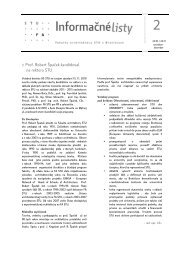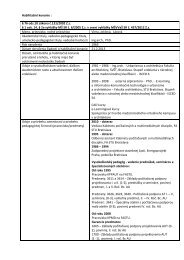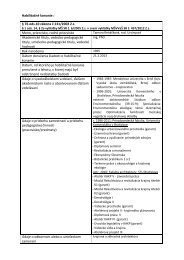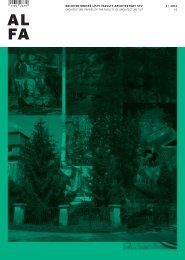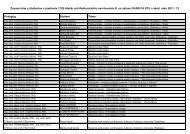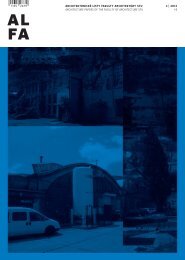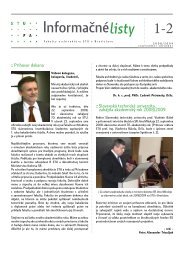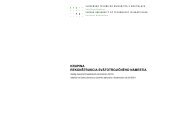ALFA 3-4/2005 - Fakulta architektúry STU
ALFA 3-4/2005 - Fakulta architektúry STU
ALFA 3-4/2005 - Fakulta architektúry STU
Create successful ePaper yourself
Turn your PDF publications into a flip-book with our unique Google optimized e-Paper software.
Ročník 9<br />
3-4 / <strong>2005</strong> ARCHITEKTONICKÉ LISTY FA <strong>STU</strong><br />
a calming blue in order to avoid too much stimulation to<br />
the nervous system. This is particularly true when using bright<br />
yellows in bedrooms of young children. Mauves and purples can<br />
be used where productivity is important because they seem to<br />
inspire new ideas and fuel original thinking. Adding a rosy red to<br />
violet to create a strong, assertive magenta may help to increase<br />
self-confidence in shy, overly sensitive people.<br />
Black or white enhances the psychological effects of colour. Used<br />
sparingly, these can add excitement and impact. Overdone, they<br />
can overwhelm the eye and waste energy. Colour speaks to us in<br />
a way that only we, as individuals, can hear. And in a world where<br />
things seem terribly imperfect at times, the art of colour can make<br />
us feel good again.<br />
Views: Patients recover faster when they have pleasant and<br />
interesting views of the outside world. It is required that all<br />
patients’ wards and patient social support areas have outside<br />
views.<br />
Arts: The arts can enrich the healthcare environment. They help<br />
to reduce patients’ stress levels by offering visual stimulation and<br />
distracting them from their health problems. A study by P. Scher<br />
(1999) “The Exeter Evaluation – Evaluation research project<br />
of Exeter health care arts” (Manchester Metropolitan University)<br />
reported that 75 percent of patients, visitors and staff respectively<br />
found that the hospital’s programme of visual and performing arts<br />
- 36 -<br />
diminished their stress levels, changed their mood for the better<br />
and helped to distract them from their immediate problems.<br />
The arts contribute to the healing environment in three ways:<br />
- Visual arts<br />
- Performing arts<br />
- Participation arts.<br />
Visual arts may be expressed in many forms such as painting,<br />
murals, prints, photographs, sculptures, decorative tile, ceramic,<br />
textile hanging and furniture. Art can celebrate life, calm patients’<br />
fears and anxieties, amuse, encourage, educate and indeed<br />
distract for long periods of time. Artwork images should impart<br />
and evoke messages of hope, joy, love, dignity, peace, energy,<br />
comfort, security, safety, growth and life. Works of art can be<br />
used as landmarks for wayfinding in hospitals in the form of<br />
icons, sculptures and water features. Artwork in a healthcare<br />
environment can:<br />
- Mitigate the stress of the environment<br />
- Educate<br />
- Be integral part of wayfinding.<br />
Researches found out that in terms of positive distraction,<br />
the performing arts have a better effect on patients than visual<br />
arts (P. Scher and P. Senior, The Exeter Evaluation, 1999). This<br />
form of art includes puppetry, musicians, opera, theatre, cinema,<br />
dancing, story telling, poetry reading, and singing.<br />
Flexible design of single rooms enable accomodation of patient’s family memebers.



